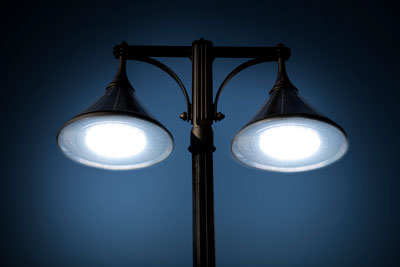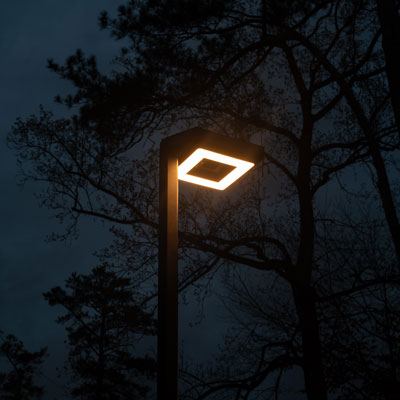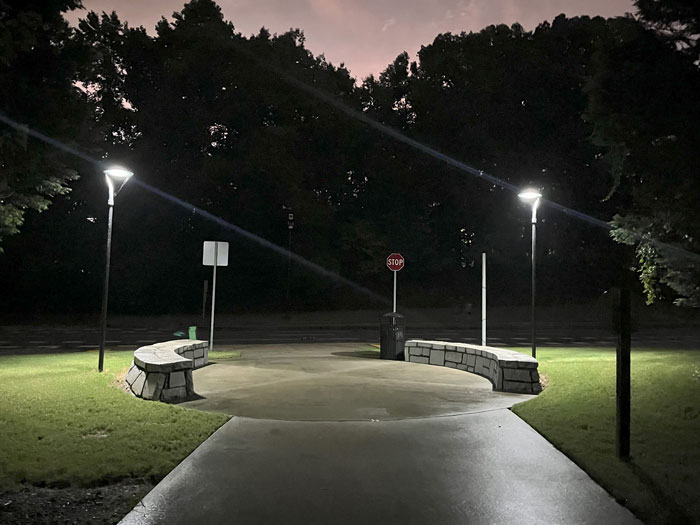 When it comes to lighting parks and recreational areas, installing new or repairing existing AC lighting requires costly and disruptive trenching, digging and wiring. Cost is increased especially in remote areas without existing electrical infrastructure. Many parks seek to control brightness throughout the night by using brighter lighting in the early evening that dims or turns off later to preserve natural habitats and manage park access. However, brightness control systems for traditional lighting can also be expensive.
When it comes to lighting parks and recreational areas, installing new or repairing existing AC lighting requires costly and disruptive trenching, digging and wiring. Cost is increased especially in remote areas without existing electrical infrastructure. Many parks seek to control brightness throughout the night by using brighter lighting in the early evening that dims or turns off later to preserve natural habitats and manage park access. However, brightness control systems for traditional lighting can also be expensive.
Solar lighting offers a simple, cost-effective alternative, eliminating the need for disruptive installations and ongoing energy expenses while addressing the unique needs of parks. We’ve created innovative solutions like integrated solar panels, Morph technology, and customizable brightness and timer settings to optimize commercial solar lighting even further. These advancements provide bright, efficient illumination without the need for large, remote panels, maintaining the natural beauty of parks. Customizable brightness and control settings allow parks to tailor lighting schedules, ensuring areas are illuminated only when needed and with the appropriate level of light.
Integrated Solar Panels
The issue of separate, bulky solar panels was addressed with a unique approach of integrating the solar panels into the light fixture. Embedding the panels directly onto the fixtures eliminates the need for unsightly remote panels. This not only creates a streamlined design but also simplifies the installation process.
“Our integrated solar panels solve the problem of aesthetics while still delivering the power needed to light up public spaces,” said Itay Parness, CEO of Gama Sonic.
Morph Technology: Solar Power for Curved Designs
While integrated solar panels work well on flat designs, we took this a step further and developed Morph technology, applying solar panels to curved or irregularly shaped fixtures. This patent-pending innovation allows solar panels to “morph” onto curved surfaces, enabling energy capture on non-flat designs. This opens up possibilities for design-
forward lighting solutions without sacrificing energy
efficiency.
“With Morph technology, we can integrate solar panels into more complex light designs without compromising aesthetics,” Parness said.
PIR Motion Sensor
A built-in PIR motion sensor can detect movement and automatically adjust brightness. When no motion is detected, the light operates at a lower brightness to conserve energy but increases to full brightness when movement is sensed. This feature is particularly useful in public spaces, providing efficient illumination only when needed, extending the life of the solar battery.
Customizable Timers
Traditional solar lighting often lacks control over operating times, with lights turning on at dusk and staying lit until the sun rises. We addressed this by developing customizable timers that allow users to program lights to operate for specific hours and turn off at designated times, optimizing energy usage while maintaining safety.
Customizable Brightness Settings
 Customizable, dynamic brightness settings take lighting technology one step further. This innovation allows for more complex programming, such as full brightness during early evening hours when foot traffic is high, reduced brightness overnight, and a return to full brightness before dawn. This approach provides flexibility, ensuring the right level of lighting based on usage patterns.
Customizable, dynamic brightness settings take lighting technology one step further. This innovation allows for more complex programming, such as full brightness during early evening hours when foot traffic is high, reduced brightness overnight, and a return to full brightness before dawn. This approach provides flexibility, ensuring the right level of lighting based on usage patterns.
Peachtree Corners, Ga., implemented this solution for a new walking trail. Post lights were programmed to operate at full brightness for 40% of the night, dim to 300 lumens for the middle 50%, and return to full brightness before dawn. Similarly, Columbus, Ga., is illuminating bus stops with increased brightness during early evening and again during pre-dawn hours when public transportation is most used. This solution provided a well-lit environment without complex installations like digging and trenching.
“Customizable brightness settings allowed us to provide a solution that catered to the specific needs of the community while conserving energy,” said Parness. “The lights adapted to the city’s requirements, providing the proper illumination when it was needed most.”
Innovations Shaping the Future
Solar lighting is making significant strides in addressing the challenges of traditional lighting systems, offering a more sustainable and cost-effective solution for public and commercial spaces. Innovations like integrated solar panels, advanced motion sensors and customizable settings are helping cities and businesses reduce energy consumption and environmental impact without sacrificing aesthetics or functionality. Innovative solar lighting solutions are paving the way for easier adoption of eco-friendly infrastructure, making it simpler for communities to embrace greener solutions for outdoor lighting needs. As these advancements continue, solar lighting is poised to play an increasingly important role in shaping the future of sustainable urban development. RM
ABOUT THE AUTHOR
Federico Aguilar is Commercial Solar Lighting, Municipal and Parks & Recreation segments manager for Gama Sonic. Federico’s passion for efficiency and the health of our planet can be traced to his technical background as an industrial engineer and his experience working with companies with a key focus on sustainability. For more information, visit www.gamasonic.com.



